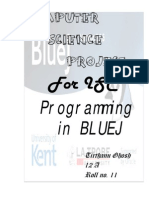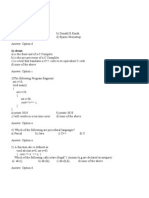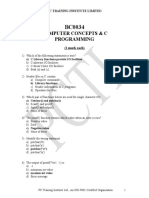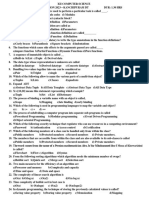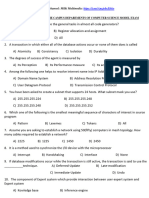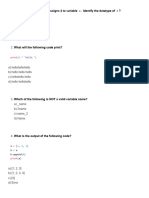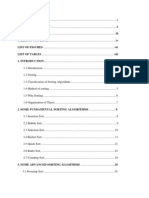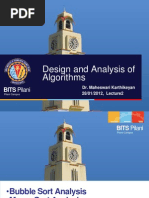0 ratings0% found this document useful (0 votes)
26 viewsMCQ's Chapter 2
MCQ's Chapter 2
Uploaded by
sabahamza97First year chapter two mcqs of book federal board
Copyright:
© All Rights Reserved
Available Formats
Download as PDF, TXT or read online from Scribd
MCQ's Chapter 2
MCQ's Chapter 2
Uploaded by
sabahamza970 ratings0% found this document useful (0 votes)
26 views4 pagesFirst year chapter two mcqs of book federal board
Original Title
MCQ`s Chapter 2
Copyright
© © All Rights Reserved
Available Formats
PDF, TXT or read online from Scribd
Share this document
Did you find this document useful?
Is this content inappropriate?
First year chapter two mcqs of book federal board
Copyright:
© All Rights Reserved
Available Formats
Download as PDF, TXT or read online from Scribd
Download as pdf or txt
0 ratings0% found this document useful (0 votes)
26 views4 pagesMCQ's Chapter 2
MCQ's Chapter 2
Uploaded by
sabahamza97First year chapter two mcqs of book federal board
Copyright:
© All Rights Reserved
Available Formats
Download as PDF, TXT or read online from Scribd
Download as pdf or txt
You are on page 1of 4
Prof Muhammad Zubair Zaib
Chapter 2: Algorithm and Computational Thinking
1. The complexity of the algorithm depends upon
A) Time Only B) Both Time and Space C) Space Only D) None of The Above
2. An algorithm: can be represented through
A) Flow Charts B) Instructions in Common Language C) Pseudo-Codes D) All of The Mentioned Above
3. There are two algorithms suppose A takes 1.41 milliseconds while B takes 0.9 milliseconds, which one is better considering
all other things are the same?
A) A Is Better Than B B) B Is Better Than A C) None of The Mentioned D) Both Are Equally Good
4. Considering an array has 10 elements and the searching element is at array index 6. A starting element is present at Index
zero. How many comparisons are required to search an element using linear search?
A) 5 b) 6 c) 7 d) 8
5. In computer science, the computational artifacts could include:
A) Programs B) Videos C) Simulations D) Programs, Simulations and Videos
6. In the planning phase of computational artifact development, the following is included in:
A) Logic B) Control Structures C) Data Structures D) Logic, Data and Control Structures
7. Trace method is used to Trace method is used to:
A) Take Input B) Take A Print C) Hand Simulate the Execution Algorithm D) Align Margins
8. Trace Tables are used to__________________
A) Dry Run Algorithm B) Test If the Algorithm Is Giving Expected Output C) Show the Variables Change D) A, B And C
9. Algorithms are evaluated using
A) Correctness B) Efficiency C) A And B D) None of The Above
10. Which of the following best describes abstraction in computational thinking?
A) Breaking down a problem into smaller, more manageable parts
B) Ignoring details to focus on the main idea
C) Identifying patterns in data
D) Writing code in a specific programming language
11. What is the main goal of pattern recognition in computational thinking?
A) Simplifying complex problems B) Developing step-by-step solutions
C) Identifying trends and regularities in data D) Translating algorithms into code
12. In computational thinking, which process involves creating general solutions that can be reused in
different scenarios?
A) Decomposition B) Abstraction C) Pattern Recognition D) Algorithm Design
13. Which computational thinking concept is used when a problem is broken down into smaller, more
manageable parts?
A) Abstraction B) Pattern Recognition C) Decomposition D) Algorithm Design
Prof Muhammad Zubair Zaib
14. What is the purpose of algorithm design in computational thinking?
A) Identifying and ignoring irrelevant details B) Breaking down a problem into smaller parts
C) Creating a step-by-step procedure to solve a problem D) Recognizing patterns in data
15. What is a computational artifact?
A) A physical object used in computing B) Any software, document, or object created using computational tools and techniques
C) A hardware component of a computer D) A type of programming error
16. Which of the following is an example of a computational artifact?
A) A printed circuit board B) A user manual for software C) A computer program D) An algorithm in pseudocode
17. What is the primary purpose of creating computational artifacts?
A) To develop new hardware components
B) To solve specific problems or address particular needs
C) To document the history of computing
D) To perform physical computing tasks
18. Which process is involved in the creation of computational artifacts?
A) Debugging B) Hardware assembly C) Software design and implementation D) Data entry
19. What might be included in the documentation of a computational artifact?
A) The source code B) Design Specification C) User Instructions D) All of the above
20. Which of the following is the first step in planning a computational artifact?
A) Writing the code B) Testing the program C) Identifying the problem or need D) Documenting the design
21 During the planning phase, what is the primary purpose of creating a flowchart or pseudocode?
A) To compile the program B) To visually represent and organize the logic of the solution
C) To conduct performance testing D) To debug the code
22. What is an important consideration when selecting tools and technologies for developing a computational artifact?
A) Popularity of the tool B) Cost of the tool
C)Suitability for the specific problem and team's expertise D) Availability of online tutorials
23. Which of the following best describes iterative development in the context of creating a computational artifact?
A) Writing the entire codebase in one go B) Testing the program only after all features are complete
C) Repeatedly refining and improving the artifact through cycles of development and testing
D) Avoiding any changes once the initial design is complete.
24. Why is user feedback important in the development of a computational artifact?
A) It helps identify bugs in the hardware
B) It ensures the final product is popular
C) It provides insights into how well the artifact meets the needs and expectations of its intended users
D) It reduces the cost of development
Prof Muhammad Zubair Zaib
25. What is the primary purpose of testing a computational artifact?
A) To increase the size of the codebase
B) To ensure that the artifact works as intended and meets the specified requirements
C)To write more documentation
D) To evaluate the hardware components
26. Which type of testing involves evaluating individual components of a computational artifact to ensure they work correctly?
A) Integration testing B) System testing C) Unit testing D) User acceptance testing
27. What is the main focus of integration testing in the context of computational artifacts?
A) Checking the user interface for errors
B) Verifying that different components or modules work together correctly
C) Ensuring that the entire system functions as a whole
D) Assessing performance under high load
28. Which testing technique involves simulating real-world usage scenarios to ensure the computational artifact performs well
under expected conditions?
A) Stress testing B) Unit testing C) Regression testing D) User acceptance testing
29. What is a key benefit of automated testing for computational artifacts?
A) It eliminates the need for a testing team
B) It speeds up the testing process and increases test coverage
C) It replaces the need for user feedback
D) It reduces the size of the codebase
30. Which sorting algorithm repeatedly compares adjacent elements and swaps them if they are in the
wrong order?
A) Merge sort B) Quick sort C) Bubble sort D) Insertion sort
31. What is the average time complexity of bubble sort?
A) O (1) B) O(n log n) C)O(n^2) D)O(n^3)
32. In which scenario does insertion sort perform the best?
A) When the list is randomly ordered B) When the list is already sorted or nearly sorted
C) When the list is in reverse order D) When the list contains unique elements
33. What is the worst-case time complexity of insertion sort?
A) O (1) B) O (n log n) C)O(n^2) D)O(n^3)
34. Which sorting algorithm is considered more efficient for small or nearly sorted lists?
A) Quick sort B) Merge sort C) Insertion sort D) Heap sort
35. How does the performance of bubble sort change if an optimized version is used that stops early if no
swaps are made?
A) It improves to O(n log n) in all cases B) It remains O(n^2) in the average and worst cases
C) It improves to O(n) in the best case (when the list is already sorted) D) It becomes more complex to implement
36. Which sorting algorithm builds the final sorted array by repeatedly moving the current element to its correct position relative
to previously sorted elements?
A) Bubble sort B) Insertion sort C) Merge sort D) Selection sort
Prof Muhammad Zubair Zaib
37. What is the space complexity of bubble sort?
A) O(1) B) O(n) C) O(n log n) D) O(n^2)
38. Which search algorithm requires the list to be sorted in order to function correctly?
A) Linear search B) Binary search C) Both linear and binary search D) Neither
39. What is the average time complexity of linear search?
A) O (1) B) O(n) C) O(log n) D) O(n log n)
40. What is the time complexity of binary search in the worst case?
A) O (1) B) O(n) C) O(log n) D) O(n log n)
41. In which search algorithm does the search space reduce by half with each iteration?
A) Linear search B) Binary search C) Jump search D) Interpolation search
42. Which search algorithm is best suited for unsorted lists?
A) Binary search B) Linear search C) Both binary and linear search D) Neither
43. What happens in binary search if the target value is not present in the list?
A) It returns the position where the target value should be inserted
B) It results in an infinite loop
C) It returns the position of the nearest smaller value
D) It returns -1 or an error indicating that the value is not found
44. What Is the primary advantage of binary search over linear search?
A) It requires less memory B) It is simpler to implement C) It has a lower time complexity for large, sorted lists
D) It works on unsorted lists
45. Which search algorithm compares each element sequentially until the target value is found?
A) Binary search B) Linear search C) Jump search D) Exponential search
Key:
1 B 2 D 3 B 4 C 5 D 6 D 7 C 8 D 9 C 10 B
11 C 12 B 13 C 14 C 15 B 16 C 17 B 18 C 19 D 20 C
21 B 22 C 23 C 24 C 25 B 26 C 27 B 28 D 29 B 30 C
31 C 32 B 33 C 34 C 35 C 36 B 37 A 38 B 39 B 40 C
41 B 42 B 43 D 44 C 45 B
You might also like
- ISC Class XII Computer Science Project JAVA ProgramsDocument77 pagesISC Class XII Computer Science Project JAVA ProgramsTed68% (141)
- It Officer MCQ PDFDocument49 pagesIt Officer MCQ PDFVikram Reddy67% (3)
- Data Structure & Algorithms: Week - 5 Fall 2018Document32 pagesData Structure & Algorithms: Week - 5 Fall 2018ali razaNo ratings yet
- Algorithmic Thinking AssessmentDocument30 pagesAlgorithmic Thinking AssessmentD IeadsatanisNo ratings yet
- COMPUTERDocument13 pagesCOMPUTERJiru AlemayehuNo ratings yet
- foc unit 2 (1)Document8 pagesfoc unit 2 (1)bobyc1810No ratings yet
- Book Back All One Word Questions and Answers CSCDocument5 pagesBook Back All One Word Questions and Answers CSCsdnsdfNo ratings yet
- Compiled SE - MCQDocument12 pagesCompiled SE - MCQv.p.patelq12No ratings yet
- Chat GPT QuestionsDocument16 pagesChat GPT Questionszainabameen.2424No ratings yet
- Cacpa 2024Document5 pagesCacpa 2024Sourav RoyNo ratings yet
- CS201 Midterm File by ZBDocument18 pagesCS201 Midterm File by ZBeratech410No ratings yet
- MULTIPLE CHOICE. Choose The One Alternative That Best Completes The Statement or Answers The QuestionDocument54 pagesMULTIPLE CHOICE. Choose The One Alternative That Best Completes The Statement or Answers The QuestionSteve StempNo ratings yet
- MCQS (Programming Constructs & AlgorithmsDocument9 pagesMCQS (Programming Constructs & AlgorithmsAravind ReddyNo ratings yet
- Sheet 2 FDocument11 pagesSheet 2 Fmohammedhanafy06No ratings yet
- Q Sta CompDocument18 pagesQ Sta Compshravan2312No ratings yet
- Principles of Programming Languages QuizizzPDF 241120 070104mohammed 241120 070200Document20 pagesPrinciples of Programming Languages QuizizzPDF 241120 070104mohammed 241120 070200bnhatm216No ratings yet
- AimlDocument129 pagesAimldndipak001No ratings yet
- Modelqs SoftwareenginerrDocument12 pagesModelqs Softwareenginerrsheham ihjamNo ratings yet
- Cpenum Midterm Test QuestionsDocument9 pagesCpenum Midterm Test QuestionsJomeljames Campaner PanganibanNo ratings yet
- It159iu AiDocument76 pagesIt159iu AiNguyễn Phúc Minh QuânNo ratings yet
- C++ MCQ Based On Learning OutcomesDocument8 pagesC++ MCQ Based On Learning OutcomesAbdi sabaNo ratings yet
- Jku 2015 Model Exam For Computer ScienceDocument15 pagesJku 2015 Model Exam For Computer SciencekayisledestaNo ratings yet
- System Analysis and DesignDocument14 pagesSystem Analysis and DesignGuruKPO100% (1)
- Time 2Document10 pagesTime 2xiler12988No ratings yet
- Sample QuestionsDocument17 pagesSample Questionsmk0616446No ratings yet
- Full Download of Management Information Systems 10th Edition McLeod Test Bank in PDF DOCX FormatDocument38 pagesFull Download of Management Information Systems 10th Edition McLeod Test Bank in PDF DOCX Formatteisiderren100% (7)
- MCQ Se&pm 2019-2020 Q & ADocument78 pagesMCQ Se&pm 2019-2020 Q & ASudhisha ZareNo ratings yet
- 2015 Model ExamDocument7 pages2015 Model ExamAyana NegeraNo ratings yet
- USS Pre-Mock FFDocument19 pagesUSS Pre-Mock FFDarryl TapsNo ratings yet
- SEPM MCQ - SBJainDocument9 pagesSEPM MCQ - SBJainApoorva RodeNo ratings yet
- Computer ScienceDocument4 pagesComputer Sciencem1234arulNo ratings yet
- 50 Objective Questions For IT Officer With AnswerDocument6 pages50 Objective Questions For IT Officer With AnswerShuseel BaralNo ratings yet
- C MCQ Test 2 (Imamoddin Answer)Document9 pagesC MCQ Test 2 (Imamoddin Answer)imamoddin15No ratings yet
- Computer Concepts C Programming Dec 2010Document4 pagesComputer Concepts C Programming Dec 2010Prasad C MNo ratings yet
- SP Cse Pjlce-PbcoeDocument66 pagesSP Cse Pjlce-PbcoeVaishNo ratings yet
- C++ ObjectiveDocument38 pagesC++ ObjectiveVidhu VohraNo ratings yet
- Namma Kalvi 12th Computer Science Model Question Papers em 2020 217201Document54 pagesNamma Kalvi 12th Computer Science Model Question Papers em 2020 217201NARAYANANNo ratings yet
- Multiple Choice Questions For Mid - 1Document26 pagesMultiple Choice Questions For Mid - 1anildudlaNo ratings yet
- PlusTwoCompSci MLM EMDocument33 pagesPlusTwoCompSci MLM EMrsgkNo ratings yet
- Computer Science Past Papers MCQS SolvedDocument24 pagesComputer Science Past Papers MCQS SolvedLEGAL AFFAIRS DIVISION100% (2)
- Tutorial-C Language-00305Document14 pagesTutorial-C Language-00305name0secondNo ratings yet
- 12TH Comp - Sci One Mark Revision 2023Document4 pages12TH Comp - Sci One Mark Revision 2023Immanuel LourduNo ratings yet
- d0cf9ce0-69d2-4b65-99a9-0d082f938791Document48 pagesd0cf9ce0-69d2-4b65-99a9-0d082f938791Hoang Ngoc Tu (K17 HL)No ratings yet
- MCQADocument14 pagesMCQAvenniraselviNo ratings yet
- 2015 Model ExamDocument15 pages2015 Model ExamDajanee LachisaNo ratings yet
- 672qb Class 11 CsDocument33 pages672qb Class 11 Csfreefirewarrior61No ratings yet
- 2020 - BCA 2 Sem Programming LanguageDocument16 pages2020 - BCA 2 Sem Programming Languagemanishkharwar.hhNo ratings yet
- 2nd Year MCQSDocument6 pages2nd Year MCQSHammaddd KtkkNo ratings yet
- MP - Ent - 20 Computer Science PDFDocument12 pagesMP - Ent - 20 Computer Science PDFSindhujaNo ratings yet
- M.Phil./Ph.D. Entrance Examination, August - 2018Document8 pagesM.Phil./Ph.D. Entrance Examination, August - 2018Firoz AminNo ratings yet
- UpdatedNew C QB-1Document2 pagesUpdatedNew C QB-1Kaushik YashNo ratings yet
- System Analysis and DesignDocument11 pagesSystem Analysis and DesignGuruKPO100% (1)
- SE Question BankDocument25 pagesSE Question BankMohammad ImthiyazNo ratings yet
- Model QuDocument12 pagesModel QuSaurav NeupaneNo ratings yet
- Se ObjectivesDocument16 pagesSe ObjectivesAnonymouseNo ratings yet
- Jku Cs IT - Model Exam Take ExamDocument19 pagesJku Cs IT - Model Exam Take ExamkayisledestaNo ratings yet
- IT Model ExamDocument22 pagesIT Model ExammatiostsintaNo ratings yet
- Namma Kalvi 12th Computer Science 1 Mark Question Paper em 216956Document14 pagesNamma Kalvi 12th Computer Science 1 Mark Question Paper em 216956rinuvj12No ratings yet
- Jku MEXFCS!Document19 pagesJku MEXFCS!kayisledestaNo ratings yet
- 2015 Model Exam For Computer ScienceDocument15 pages2015 Model Exam For Computer ScienceMercy DegaNo ratings yet
- End Module A Mock QuestionsDocument28 pagesEnd Module A Mock QuestionsProdigy Study circleNo ratings yet
- CS504 MidTerm MCQs by Talha SajidDocument37 pagesCS504 MidTerm MCQs by Talha SajidTalha SajidNo ratings yet
- MH3400 Lecture 1 Jan 13 2015Document40 pagesMH3400 Lecture 1 Jan 13 2015Son NguyenNo ratings yet
- DAA - Lab - Manual - 1.1Document77 pagesDAA - Lab - Manual - 1.1ANONYMOUS ENTITY : ]No ratings yet
- DAA or Algorithms in 9 HoursDocument344 pagesDAA or Algorithms in 9 Hourssomanishelendra3No ratings yet
- Searching and Sorting Algorithms: CS117, Spring 2006 Supplementary Lecture Notes Written by Amy Csizmar DalalDocument15 pagesSearching and Sorting Algorithms: CS117, Spring 2006 Supplementary Lecture Notes Written by Amy Csizmar DalalVishnu SalunkheNo ratings yet
- C Programming Answers PDFDocument77 pagesC Programming Answers PDFAtharv ChavanNo ratings yet
- Data Structures Se E&Tc List of PracticalsDocument23 pagesData Structures Se E&Tc List of Practicalsdhruv_bhattacharya_1No ratings yet
- PTTKGTDocument124 pagesPTTKGTkhaiNo ratings yet
- Dsa Presentation 1Document76 pagesDsa Presentation 1tashatakia3No ratings yet
- Python NotesDocument16 pagesPython NotesSayar HeinNo ratings yet
- ppt dsaDocument12 pagesppt dsa38 Tô Văn ThànhNo ratings yet
- Sorting Algorithms: Bubble, Insertion, Selection, Quick, Merge, Bucket, Radix, HeapDocument24 pagesSorting Algorithms: Bubble, Insertion, Selection, Quick, Merge, Bucket, Radix, HeapAryan ApteNo ratings yet
- mcs21 - NotesDocument23 pagesmcs21 - NotesAAkashNo ratings yet
- Quiz 005Document3 pagesQuiz 005JOHNSON KORAINo ratings yet
- 10 Activity 1Document2 pages10 Activity 1MingNo ratings yet
- Presentation: Bitonic Sort: Presented By: Eng Zahir UllahDocument11 pagesPresentation: Bitonic Sort: Presented By: Eng Zahir UllahZahir UllahNo ratings yet
- DSA Ch10 11 SortingDocument63 pagesDSA Ch10 11 SortingĐẠT PHẠM TIẾNNo ratings yet
- DSA With Java - Unit 8Document32 pagesDSA With Java - Unit 8Sabin MaharjanNo ratings yet
- Sorting AlgorithmDocument132 pagesSorting Algorithmanujgit100% (3)
- DS LabDocument17 pagesDS LabGUHINo ratings yet
- Block-1 MS-031 Unit-3Document57 pagesBlock-1 MS-031 Unit-3Arjun SharadNo ratings yet
- Daa PPT 28th JanDocument35 pagesDaa PPT 28th JanccattyNo ratings yet
- FAIPS, DPS Kuwait Page 1 of 24 © Bikram AllyDocument52 pagesFAIPS, DPS Kuwait Page 1 of 24 © Bikram AllyMohammed FahadNo ratings yet
- Chapter 2Document21 pagesChapter 2sabahamza97No ratings yet
- CME Detalied Topic Wise SyllabusDocument15 pagesCME Detalied Topic Wise Syllabusssrkm guptaNo ratings yet
- Python Practical Record AnnaDocument69 pagesPython Practical Record AnnaGunjan JainNo ratings yet
- Friday 22 May 2020 - Morning: © OCR 2020 (601/5030/0) DC (LK) 207720/1Document32 pagesFriday 22 May 2020 - Morning: © OCR 2020 (601/5030/0) DC (LK) 207720/1riyakutty0506No ratings yet
- Lab4 DsaDocument3 pagesLab4 DsaAlishba SoomroNo ratings yet
